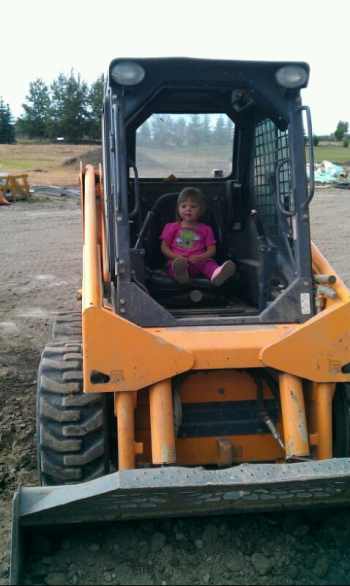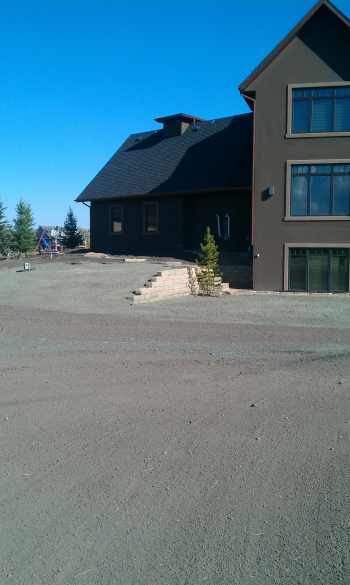D. Grading Soil for Seeding
Grading soil in preparation for seeding may not be complicated or difficult, but we suggest you consider contracting this part of the job to professionals. Their experience combined with their equipment, is very hard to compete with.
Having an experienced equipment operator grading soil can save you time and money. The amount of work done by an experienced bobcat operator in few hours, could take you a day or two, depending on your abilities.
Here is an example to help you better understand what we are saying.
Although I was experienced with operating equipment, I still saved money subcontracting certain jobs to outside companies. Outside companies charged me per/hour for having equipment on location, but they usually weren't there very long. This allowed me to utilize my time on another project.

This is especially important to consider when you have anything that has to be removed from a property.
My contractor could bring me a load of soil, grade it out, and remove fill material with his dump truck.
Generally, it costs $350 to $450 per day in my area just for a bobcat. So how much more would it cost to have someone load up any fill material to be disposed of?
As you can see, It pays to have someone with all the right equipment for the job.
Sometimes their hourly rate may appear high, but it may only take them a few hours. Think about how much time and money it will take you?
If you are going to spread the topsoil yourself, than you should understand how to achieve proper drainage by using swales, and berms.
Working with different devices for reading levels
If it's obvious to you where the water goes, then you should have no problems grading soil. If you have a large or more complicated yard, then it may be a good idea to have someone transit your yard. They will be able to mark elevations and grade changes. You can spread your loam accordingly once these are marked.
You can also achieve the same goal with a laser level. There is an advantage of transiting and laser leveling from the lowest point in your yard. From here, you can mark on as many stakes in your line of site as you need to while getting a great read of the grade changes on your property. grading soil for proper drainage is easy when you know your yard.
String levels are another way to read grade changes, and are easily used by do-it-yourselfers. For this, tightly tied string between two stakes over the area of questionable slope is all you need. From there, you can then attach a string level to the line. By having someone move the the string up or down at one end you can watch the level to see which way it slopes.
The most basic and easiest way is simple gravity. This only requires watching the flow of water when it rains. Or imitating rain with a garden hose. If your budget or abilities do not allow other methods, than this is the least we want you to do. We can't be there to make sure you prepare your yard properly, but you absolutely must have proper drainage.
Whatever method you choose, just be sure that you are always draining water away from the house. Some of you may have specific by-laws on where you can drain your surface water. It is up to you to contact your local by-law office before you begin anything in your yard. This is so you know the rules, regulations, and what permits may be required.
I also mentioned before about talking to your neighbour about coordinating your efforts. This is important when you can work together between your properties using berms, or swales.
A swale is just a very slight ditch to collect water from two higher areas, and channel it away to another point off the property. (Like a road or back alley.)
A berm is just the reverse of a swale, there to stop water from flowing into whatever is behind it. You should use berms or swales to direct the flow of water accordingly.

This acreage was prepared for hydraseeding using a large tractor with a drag behind rake. Using the right equipment for the job saves time and money.
Spreading loam
Most landscape companies will have a small crew when grading soil for sod or hydraseeding.
One person, usually in a bobcat, will spread and back blade the soil and a couple of people will rake it.
This is where your landscape rake comes in handy. A landscape rake is much wider than a normal rake.
This extra width creates smoother grades by covering more area.
Always rake in both directions with a landscape rake, to eliminate having low spots where water can accumulate.
The weight of the equipment can have both negative and positive effects when you are grading soil.
Negative
If you are grading soil with a bobcat, it's a good idea to start spreading soil at the furthest point from your loam pile first. You can work your way back from there. This will help avoid over packing the soil by the equipment wheel tracks. (You can create mounds that are pretty hard to cut down if you aren't careful.) If you are using a wheelbarrow for smaller yards this shouldn't be an issue for you.
Positive
A bobcat can also be used to pack in heavy amounts of loam. This is good when you need to build up soil depth. Multiple passes over the loam with the wheel tracks will firm it up. You will have better success if you do this in 2 to 3 inch layers. This will help prevent soft soupy areas in your yard when you are building up.
NOTE: When grading soil, make sure there are no sharp rises or drops that will cause your mower to mulch, or scalp the grass.
If you can't pack down the soil with heavy equipment, use a water filled roller barrel, or foot pack it. It is a myth that a water barrel is used to pack soil. They are used for rolling sod or seeds to ensure good contact of the roots and seeds to the soil, and removing small air pockets under sod.
If you need to use a water barrel to try and pack soil, make sure you build it up and roll it in very thin layers. it will not pack more than about an inch of soil.
Once you have spread, packed down, and raked the soil to where it should be, you can foot pack the perimeters. Fence lines, houses, and driveways are hard to pack with equipment. Foot packing helps greatly in areas that are hard to get at.
If you are happy with you final grade, then you can start spreading your starter fertilizer. Coverage should be at least two pounds (up to three pounds) for every 1000 sq. ft. or so.
Now you are ready to seed your yard.
_____________________________________
Table of Contents: Seeding a Lawn
A. Seeding Site
C. Selecting and Estimating Seeding Materials
F. Seeding Completion and Clean-up
______________________________________
Go to The Yard: How-to Modules
Return to the Dream Yard Home Page from Grading soil
Check out our time and money saving e-book
How to avoid the biggest mistakes made by DIYers, designers, and landscaping companies.
Visitor
Favorites
Giggles 'n' Thoughts





